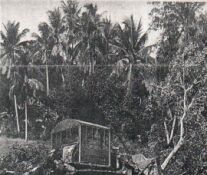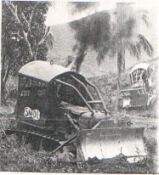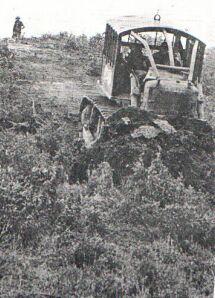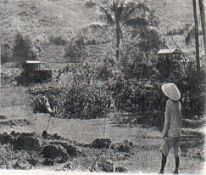|
The countryside surrounding the camp had been stripped bare,
its rolling surface of trees, brush, and grass peeled like an
orange to reveal the red soil beneath. For almost a month,
the engineers of the 538th Land Clearing Company had been
cutting their way across Tam Quan District, working down the
coast from Snipers Island and then swinging inward near
Highway QL-1. By early October they were at their third
campsite of the operation--a small hill at the base of Monster
Mountain. The name of the camp was the same as the previous
ones; it had followed them from site to site like the huge
swath of cleared land. They called it LZ Rome Plow. |
|
The 538th was sent into Tam Quan District to help destroy the
hold the VC had on the area. The people are isolated; they
have almost no contact with the Government of Vietnam. The
thick jungle growth in the mountains provided unlimited hiding
places for the VC, while the countless hedgerows served as
secure avenues of approach and escape. Mines and booby traps
took their toll daily on units operating in the area. |
 |
|
|
|
The people were safe while they
worked in the fields. But
when they returned to their homes at night, the VC came after
their rice and young men. With this lack of security, the
villages soon came under heavy VC influence. "Our
Infantry. "The kids would run patrols couldn't even go out
secretly," said Captain Ralph Bleskan, CO of Alpha Company,
4th Battalion, 503d and
tell the VC where we were, then Charlie would either ambush
us or hide. |
|
The people were safe while they worked in the fields. But
when they returned to their homes at night, the VC came after
their rice and young men. With this lack of security, the
villages soon came under heavy VC influence. "Our patrols
couldn't even go out secretly," said Captain Ralph Bleskan, CO
of Alpha Company, 4th Battalion, 503d Infantry. "The kids
would run and tell the VC where we were, then Charlie would
either ambush us or hide. |
|
Increasing US troop concentration in the area would not solve
the problem, because the soldiers could not remain there
forever. Something had to be done which would allow the
Vietnamese Regional and Popular Forces (RF's and PF's) to
aggressively patrol the area with minimum US support. The
likely solution was to destroy Charlie's hiding places and
eliminate his avenues of movement. No unit was better
qualified for the job than the 538th. |
|
Proceeding with the operation was not a simple task. The land
clearing company could not just set up camp and begin knocking
down everything in sight. So before the 538th arrived in Tam
Quan District, the 173d Airborne Brigade "prepared" the area
by conducting a concerted psychological (PSYOPs) and
pacification program. |
|
Thousands of leaflets were dropped in the four-hamlet area,
telling the Vietnamese that the 538th was coming. Helicopters
flew over the villages, broadcasting messages from their
chiefs which explained the forthcoming operation. Some of the
villages were spread out too far for good security, so it was
decided to relocate the families. Elements of the 173d took
their armored personnel carriers (APC's) to each of these
villages, then swept through the area with the chief so he
could inform his people of the relocation sites which would be
provided for them. |
|
After three weeks of such preparation, the area was ready for
the 538th. With the 173d providing security, the engineers
methodically began working down through the district. Just
after heading west near QL-1, the soldiers relocated an entire
village, houses and all, to an area near a US-ARVN command
post. Within three weeks they had almost reached Monster
Mountain, located roughly halfway between LZ English and the
South China Sea |
|
For their move to the base of the mountain, the 538th sent
four plows ahead to work on the new site, leaving the rest of
the company behind to finish the cut and tear down the old
camp. "We don't like to move the whole company in until the
site is ready," said Captain Ronald Swann, CO of the 538th
from Asheville, N.C. "All the plows would just get in the way
on the hill and they'd also be sitting ducks." |
 |
|
Rome plows from the 538th
Land Clearing Company worked both the hills and flat-lands
during their month-long operation in Binh Dinh Province,
stripping the land to deny the enemy his valuable cover. |
|
|
The first plows at the new site set to work skimming the top
of the hill to clear away any mines. Then they pushed up a
five-foot berm and plowed the inner surface, leveling spots
for the tactical operations center and mess, commo, and
maintenance sections. Finally they dug slots in the berm for
the tanks and the APCs and smoothed out places for the tents.
This work took almost the entire day. When the rest of the
company arrived the next day, the plows began clearing the
slopes outside the berm |
|
Plans for clearing the area did not call for the 538th to
strip Monster Mountain, a known VC sanctuary, though many of
the engineers obviously would have enjoyed tackling the steep
slopes with their plows. Instead the company split up to work
the front and back, each group clearing the smaller hills and
hedgerows and cutting a 5-meter strip along the base of the
mountain. "Charlie usually stays out of the area when we're
around," said Captain Swann. "But after we leave he'll come
back to work. Then he'll be detected coming out of the
mountain because his cover has been destroyed |
|
During the operation, the engineers worked closely with the
village chiefs and mobile advisory team (MAT team) to
determine where and what the plows would actually cut. The
men were directed to stay away from the houses, graves, and
crops. If they discovered an abandoned house or weren't sure
about an area they consulted the village chief before
proceeding, to make sure they wouldn't cause any hard
feelings. |
|
The terrain of Tam Quan District was a combination of almost
everything the engineers had ever cleared before. Even though
the mountain was avoided, there were many steep slopes that
forced a driver to ride with his feet braced up against the
instrument panel to keep from falling out of the cab. In
places the jungle was so dense that only black puffs of diesel
smoke were visible as a plow wrestled with the thick growth. |
|
Hedgerow stretched out in endless lines, full of tall trees to
be felled with thunderous crashes. And there were rolling
hills, lightly covered with brush, where a man could plod up
and down, scraping away row after row, until the slope was
naked. |
|
Though the name "Rome Plow" is generally used when describing
land clearing operations, the engineers actually use two
different types of blades on their plows: the Rome blade and
the bull blade. The latter, which is a normal bulldozer
blade, works best in an area where the ground has to be
scraped clean because it can dig below the surface. It is
also invaluable for constructing campsites and stream
crossings. |
|
The Rome blade is better suited for the thick jungle. It has
a sharp cutting edge and is canted at a 30-degree angle so
debris slides off to the right as the plow moves along. The
blade is also equipped with a "stinger", a wedge-like
projectile mounted on the leading left edge which allows the
operator to split larger trees before felling them with the
cutting edge. |

|
Clearing land is a dirty and dangerous job. The work-day
is long, beginning with a two-hour stand down every
morning while the men perform the necessary maintenance on
their plows. After a single-file drive to the cut, each
man settles down in his cage-like cab, a private world
where even his thoughts are drowned out by the roar of the
diesel engine. With flak jacket and steel pot on, he
soaks his uniform with sweat when the sun climbs in the
sky and shivers miserably when the driving sheets of
monsoon rain sweep through the cab. Even when the weather
is tolerable, there are enough ants, bees, and tree snakes
around to cause the operator concern. |
|
A brief
respite from working in the thick jungle growth.
Here an engineer plods downhill, making the first of many
cuts which will leave the slopes completely barren. |
|
|
Yet, these are mild irritations compared
to the real danger these men face daily. They always
lead the way into an area, exposing themselves to any mines or
booby traps.
Even when the land clearing is in
process, the APC's and tanks will attempt to follow in the
plows' tracks. The engineers have hit explosive devices
ranging from claymores and "Bouncing Betty's" to
anti-tank mines.The VC like
to place them in areas where the plows are almost sure to
travel, such as stream crossings and hedgerows. The drivers
will tell you that they feel safe in the cab, protected in
front and beneath by thick metal. Yet they have seen the harm
flying shrapnel can do when a mine is detonated in just the
right spot, and you know the fear is there. |
|
Clearing the ground of its vegetation, the plows naturally
uncovered Charlie's hiding places. The engineers found over
70 tunnels and bunkers in Tam Quan District during the month
of September. But it was too time-consuming for the plows to
stop and fill them all in. They would just call over someone
from a nearby tank or APC to check it out and then destroy it. |
|
When the plows returned in the early evening, you first heard
their low rumbling off in the distance, then saw them as black
spots crawling across the landscape. Pulling up inside the
berm, the men jumped from the cabs and headed straight for
their tents to get a beer or a soda. Barechested and sweaty,
they plopped onto cots, chairs, and footlockers and let
themselves unwind for a moment. |
|
Soon most of the men stripped off the rest of their dirty
clothes and walked to the water truck. Dinner could wait;
nothing in the world could feel better at the moment than a
cold shower. The water was sandy as it gushed from the
faucets, but no one really complained. It removed the dirt
and sweat of a long day and helped awaken a tired mind. And
that was all that mattered. |
|
The hot meal went down fast, then it was back to the tents.
The men hooked up the truck headlights which they had hung
inside, for it was already getting dark. Mail was brought in,
the first in several days, and they settled down to read the
long-awaited letters. Those who got none grabbed eagerly for
the week-old Stars and Stripes. |
|
One of the men received a large envelope from his
sister--a teacher. She had enclosed letters from her
entire class of 5th grade students. The engineers
gathered around as each was read aloud, bursting into
laughter at the wondrous questions a child could think
up to ask a soldier in Vietnam. The men seemed to make
the most of the moment, enjoying the warmth of
friendship. The mood explained a statement which
Specialist Four Mike Horowitz, West Lake Village,
Calif., had made earlier in the day, "You've only
got a
few things to return to after a day out on the cut--a
shower, a hot meal, and your friends. If you don't
enjoy the people here, there's not much left." |
|
 |
|
An old man watches in
silence as Rome plows clear the hedgerows around his
village. When working near a village, the engineers are
careful not to disturb the crops, graves, and houses. |
|
|
The tent lights were off by 9:30, most of the men already
asleep while turned-down radios droned on and on. Specialist
Horowitz was one of the few still awake, finishing a letter by
a flickering lantern. "You know, our job is funny," he said.
"Most of the engineer units here spend their time constructing
things--bridges, highways, houses. We do just the opposite,
stripping the land to help the people." |
|
It was hard to tell if he was defending his job, or trying to
determine for himself what he was accomplishing. But one
thing was certain. He would have all next day on the cut, and
many more after that, to think about it. |
|
Article submitted by: Jim Herman |